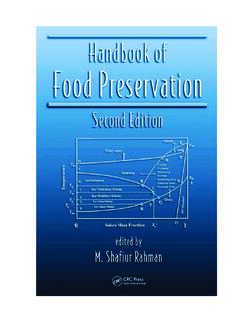Transcription of FLAVOR AND ODOR DEFECTS IN MILK - Cornell Food …
1 SENSORY EVALUATION OF milk & DAIRY PRODUCTS FLAVOR AND ODOR DEFECTS IN milk (AND OTHER DAIRY PRODUCTS) Good quality milk should have a pleasantly sweet and clean FLAVOR with no distinct aftertaste. Because of the perishability of milk and the nature of milk production and handling procedures, the development of off-flavors/odors is not uncommon. To prevent FLAVOR /odor DEFECTS in milk , proper milk handling procedures from the farm to the consumer are essential. This guideline will describe the common FLAVOR and odor DEFECTS found in milk and their potential causes.
2 These DEFECTS may be classified according to the ABC's of off-flavors: Absorbed/Transmitted Bacterial/Microbial Chemical/Enzymatic/Processing Absorbed -- feedy, barny, cowy, weedy, unclean, lacks freshness, stale, refrigerator/cooler odors. Raw or pasteurized milk products can absorb flavors during production, storage and distribution. On the farm, off-flavors can be absorbed, or more correctly transmitted, through the bloodstream of the cow from the lungs and/or rumen into the milk in the udder ( , onion/garlic, feedy, barny, cowy).
3 Similar off-flavors may be absorbed into the milk during farm storage if ventilation is poor and the milk is not protected. Pasteurized milk can absorb flavors during refrigeration storage, especially in paperboard or low barrier cartons. Examples of off-flavors that might be absorbed include volatile compounds of fruits or vegetables or unclean odors associated with poorly cleaned milk coolers. Absorption of flavors by packaged milk can occur at the plant, in the supermarket or in the consumers home refrigerators. Bacterial -- acid, bitter, malty, lacks freshness, unclean, fruity/fermented, putrid and rancid.
4 Bacterial and other microbial ( , yeast or molds) off-flavors result from the growth of microorganisms that are present in milk due to poor sanitation and/or milk handling practices. Bacteria that are able to grow at refrigeration temperatures ( 45 C), or psychrotrophic bacteria, are most often responsible for spoiling refrigerated milks. The type of spoilage ( , fruity, rancid, acid) depends on the predominant type(s) of bacteria present and generally occurs when bacterial numbers ( , Standard Plate Count) exceed one to ten million per milliliter.
5 The time it takes for bacteria counts to reach spoilage levels depends on the initial numbers of bacteria and the temperature of storage; the warmer the storage temperature, the quicker bacteria grow and produce off-flavors and the shorter the shelf-life. If the raw milk quality is good and post-pasteurization contamination is prevented during processing, the numbers of microorganisms should not reach spoilage levels before 14-21 days when milk is held under proper refrigeration. Bacterial and other microbial DEFECTS can occur in raw or pasteurized milk and in other dairy products.
6 Chemical -- cowy (ketosis), salty, rancid, bitter, oxidized, sunlight, foreign, astringent, medicinal, flat, cooked. Chemical and enzymatic DEFECTS can occur in both raw and pasteurized milk . The cows may be suffering from ketosis (rare) or mastitis, which can affect milk FLAVOR . Abusive handling of raw milk may result in a rancid FLAVOR from the action of the naturally occurring lipase enzyme, which breaks down butterfat to free fatty acids ( , butyric acid is perceived as rancid ). Oxidized flavors can be induced by heavy metals, particularly copper, or by exposure to sunlight and fluorescent lights.
7 Chemical or foreign off-flavors can also occur due to contamination with cleaning chemicals, sanitizers, medicines, or other substances during production or processing. Processing parameters, if not managed properly, can result in off-flavors including cooked (from high heat) or flat (from added water). A complete description of the characteristics of milk DEFECTS & guidelines for milk judging & scoring follows. **Adapted from milk FLAVOR & Quality (1984) by Bandler & Barnard and Bodyfelt et al, The Sensory Evaluation of Dairy Products.
8 An update of a Bandler Handout prepared by S. Murphy, Department of food Science, Cornell University, 2 CHARACTERISTICS OF milk OFF-FLAVORS Typical milk No criticism. Very little distinct odor, pleasantly sweet and clean with no aftertaste. Acid Basic taste sensation. Sour, tart, may cause tingling sensation on tongue. Cultured milk or sour odor may be present. Cause - Growth of lactic acid producing organisms such as Lactococcus lactis, due to poor refrigeration, especially when temperatures exceed 70 F (21 C). Malty milks may be acid also.
9 Astringent Peculiar mouth-feel, tongue & mouth lining feel shriveled, puckered, chalky ( , cranberry juice). Cause - Associated with denatured proteins due to high heat treatments or with staleness ( , milk powder). May be more pronounced in skim milks and in Ultra High Temperature (UHT) or Ultra-Pasteurized (UP) products. Occasionally occurs with slight rancid, bitter or acid milk . Barny Unpleasant odor and taste of a poorly maintained barn or unpleasant feed. May be perceived as unclean. Cowy or cow's-breath may present a similar defect but generally with an unpleasant medicinal or chemical ( , acetone) aftertaste.
10 Cause - absorbed, transmitted odor/ FLAVOR due to cow inhaling barn odors associated with poor ventilation and unclean barn conditions. Similar defect may be due to ketosis in cows, but with more of a medicinal or chemical after taste (see cowy). Bitter Basic taste sensation. Pure bitter has no odor. Taste sensation is detected on the tongue after expectoration (delayed) and tends to persist. ( , hops in beer, coffee may be bitter) Cause - enzymatic breakdown (microbial or milk enzymes) of milk proteins to short bitter peptides.




